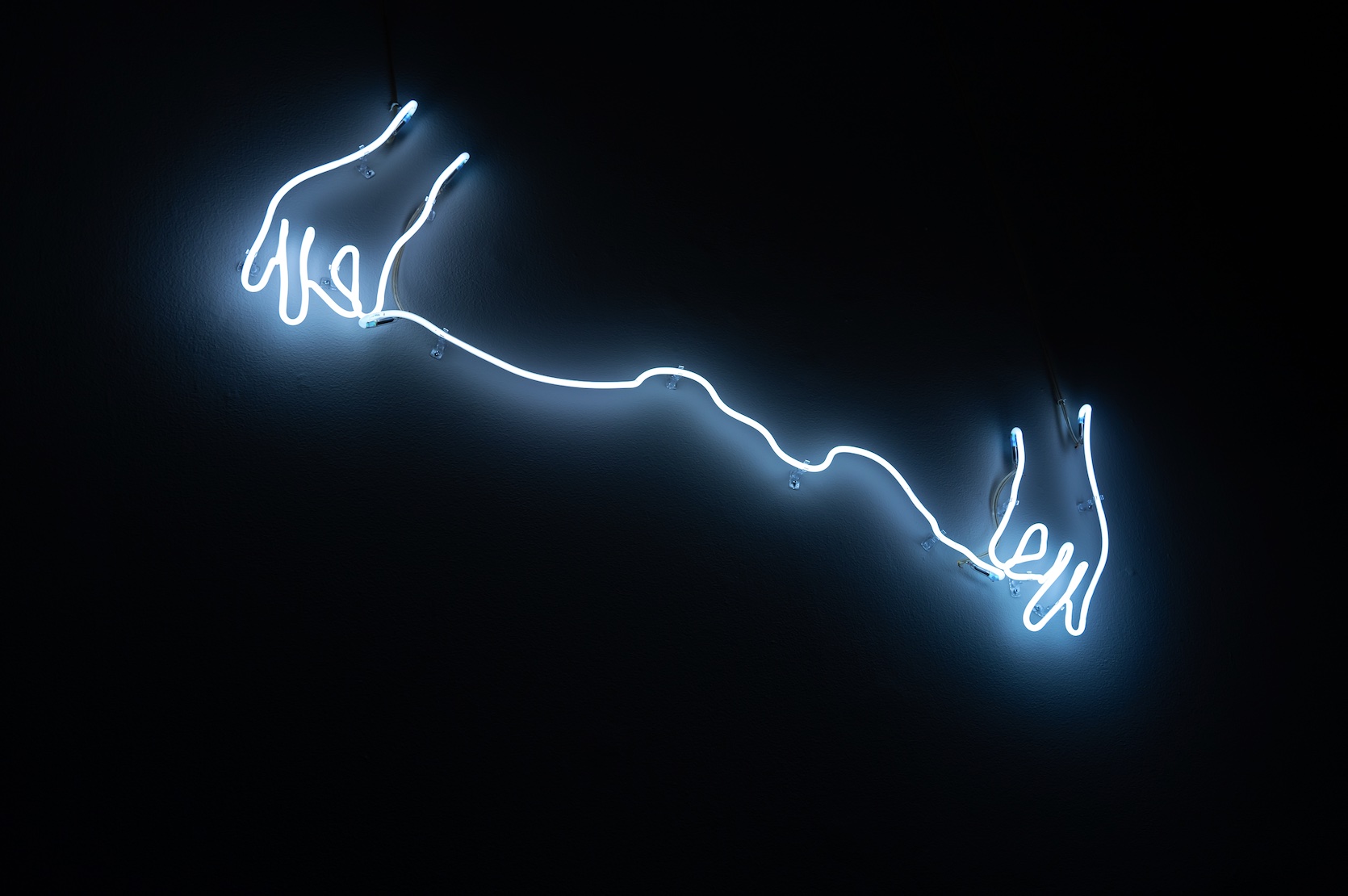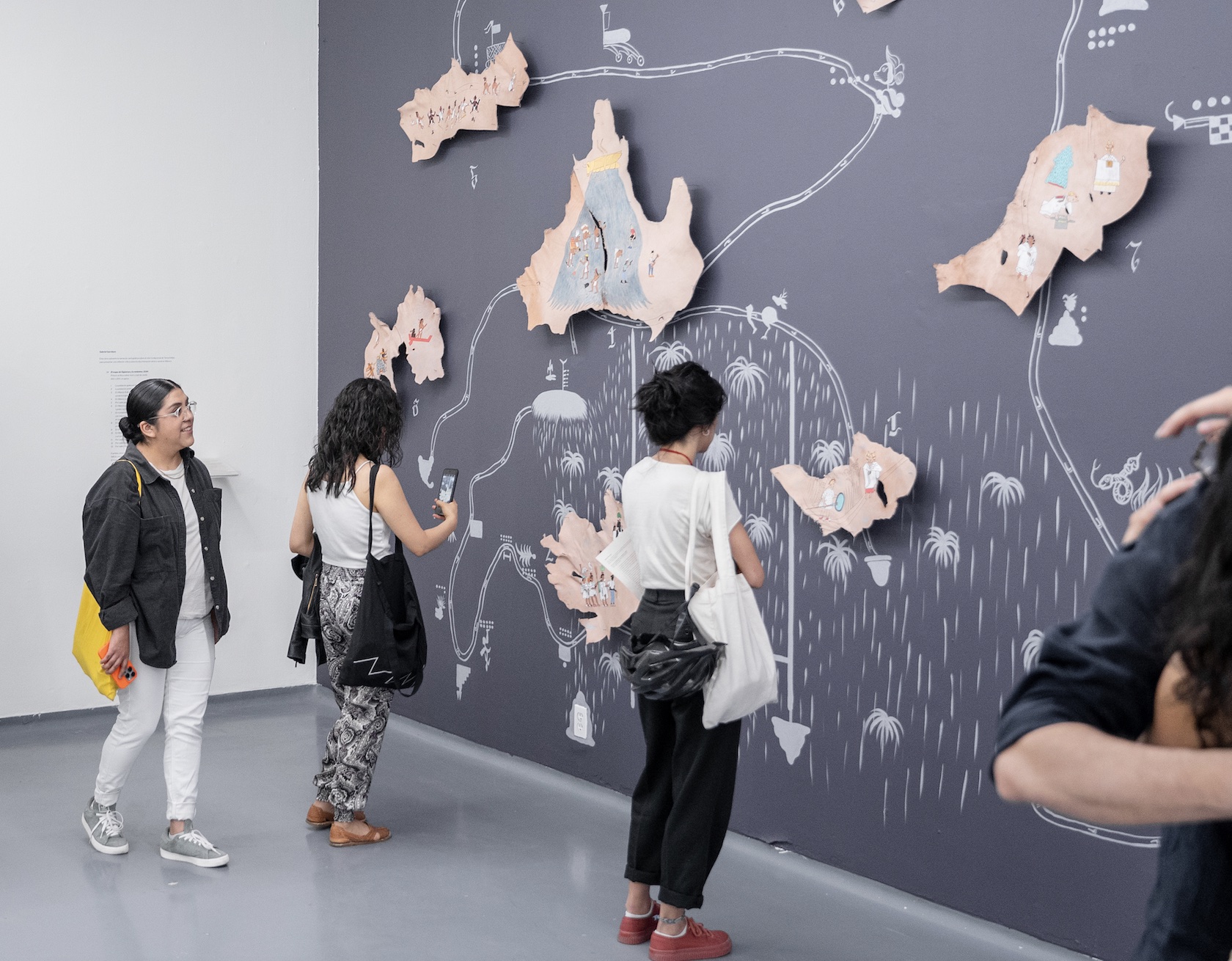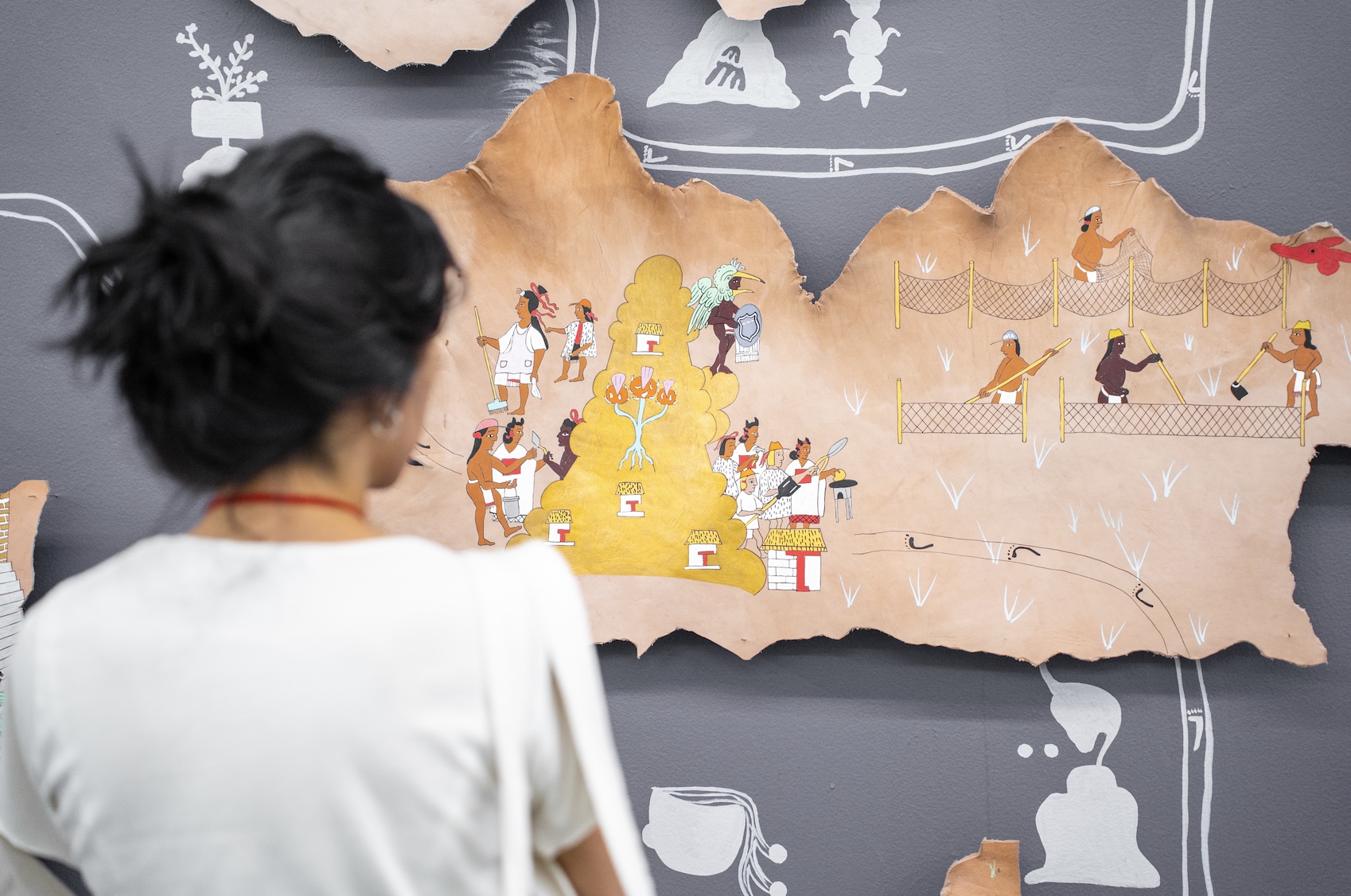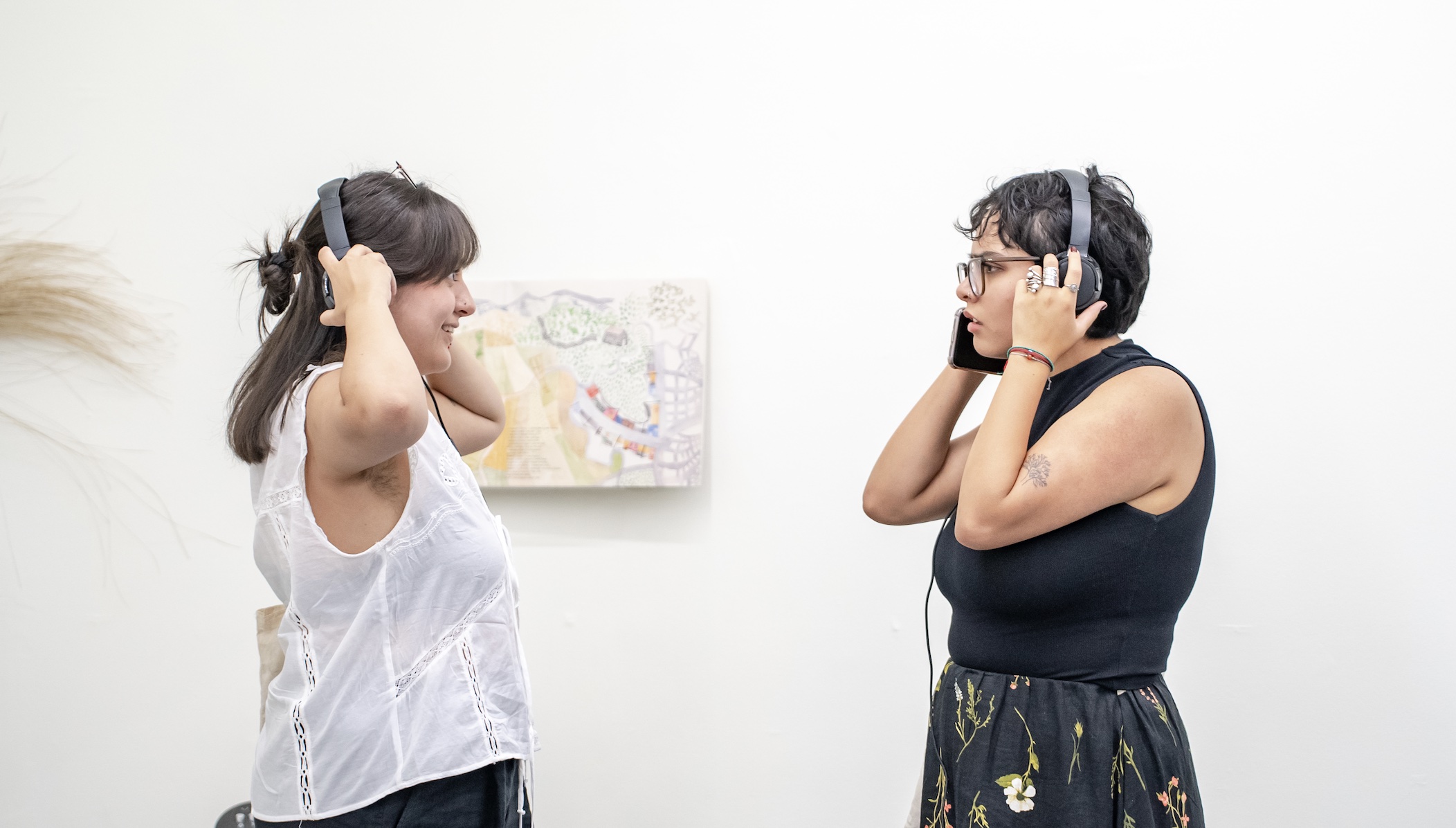
Review
Poles “a” and “b” in ‘Dibújame un mapa de lo que no verás’ at Casa del Lago UNAM
by Sofía Gómez Luna
Reading time
5 min
Speculatively, the conception of a map moves along a spectrum that begins with pole “a” and slides towards pole “b.” Pole “a” is attributed to the academic, the supposedly objective, where boundaries and borders are coldly delineated. These are the traditional maps where certain countries are distorted to maintain the characteristic shapes of central ones. They are small and mostly have a pedagogical background. We are supposed to ignore that all representation decisions in these types of maps generate a discourse, which tends to be unfavorable to already marginalized groups. The north is always above the south. They aim to visually translate the world onto a sheet “as it is.”
At pole “b,” we see connections and routes. It may seem more “subjective” as it includes our preferred paths and landmarks that catch our attention for any reason. Turning left past the corner the striped cat likes, for example. These “b” maps include subway station maps. Each entity has its name and associated image where boundaries indicate a “you have arrived!” rather than a “you are no longer in” or “this is where it begins.” Less traditional maps also fall into this category, those woven by memories and dictated by all sensory experiences.

At Casa del Lago, UNAM, Adriana Melchor and Mónica Ramírez propose a curatorship of various pieces that decipher the possible uses of maps to express our discontents, desires, and realities. Dibújame un mapa de lo que no verás [Draw Me a Map of What You Will Not See] seeks to explore different notions of what is or is not a map; collecting video performances, chromolithographs, prints, a screen, embroideries, and audio pieces that transport the visitor to different spaces.
Pole “a” - Challenging Cartography
Gabriel Garcilazo’s El mapa de Sigüenza y la melanina [Map of Sigüenza and Melanin] consists of different pieces of pigskin cut to resemble the shapes we see in representations of Tenochtitlan. On them, he uses acrylic paint to depict figures making a clear distinction between prietos [“dark-skinned”] and güeros [“light-skinned”] individuals. He uses the tool that usually makes indigenous populations invisible to reclaim and denounce them: the cartographic map. Instead of containing a legend, the artist includes statistical data on systemic racial discrimination in the technical sheet, naming each piece with a fact. Some of these statements are: “The prieto population in Mexico represents between 70 and 80% of the total'' and “In Mexico, 8 out of 10 people born at the bottom of the social ladder do not overcome poverty.”

By using a visual language and vocabulary that adheres to the academic, Garcilazo emphasizes the importance of the colors impregnated in the pigskin. This approach takes us out of the monotony of sepia maps, where the only relevant issue is the distribution of territories, a central problem in the abuse of indigenous peoples. It refers to ideas scattered in the Laws of the Indies, which sought to protect these communities but maintained both the system of abuses and the theft of territories and resources. Similarly, by giving so much importance to color, the discussion of racism is opened: it leads us to question how Mexican identity, like a map, has been deformed and mutilated.

Pole “b” - Gastronomic Topography
The oracle installation initially lacked an obvious connection to the map. In a space filled with paintings, drawings, and embroideries, there is a giant comal with legs, a pair of headphones, and metal chairs around it. The curatorship allowed me to walk through the rooms in an orderly manner, without skipping anything, and end with Oracle of the Tortillas: The Future Puffed Up, Eat Your Tortillas (duo) by Mariana Castillo Deball and Carlos Sandoval, which caught my attention from the beginning. As I sat down and put on the headphones, a track began. In it, a female voice reads the oracle of a girl named Rita, based on the cooking and sound of the tortillas made by the reader. She places the dough balls on key points of the comal, which are related to the following five powers: destiny, guide, ally, opposite, and action.
If the tortilla puffs up, it’s a good sign; if it doesn’t, there’s no need to worry. These words are complemented by auditory conversations, cars in the vicinity, bicycles, speakers with music, the sound of water moistening the dough, and the tortilla press being pressed. In the reading, it is advised to ask for help from a loved one and offer the same in return. This piece generates two maps: the first is topographic, traced on the giant comal, where we imagine tortilla dough steaming and puffing up; the second is constructed similarly with our imagination, this time with the sounds surrounding the oracle reading, i.e., the physical space where the comal and chairs might be found. It is important to forget the presence of the headphones to enjoy this piece.

Regardless of one’s own conception of what constitutes a map, Dibújame un mapa de lo que no verás challenges us by immersing us in the proposals of the pieces. The diversity in themes and techniques employed, which expand this concept as a tool, takes us to every corner of identity, thus glimpsing the power of maps as a means of expression. The exhibition also features the work of Antonia Alarcón, Wendy Cabrera Rubio y Charlotte González, Miguel Covarrubias, María García Ibáñez, Justino Fernández, Alejandro “Luperca” Morales, Michelle Sáenz Burrola, Alan Sierra, Vladimir Kibalchich Rusakov “Vlady” y Marek Wolfryd.
The exhibition is closed for the vacation period and will be open again from July 24th until November 17th, 2024.
Translated to English por Luis Sokol
Cover picture: Alan Sierra, Un hilo colocado con cuidado sobre un mapa por dos manos que vienen desde arriba o La frontera, exhibition 'Dibújame un mapa de lo que no verás’. Photo: Mara Arteaga. Courtesy Casa del Lago UNAM
Published on July 14 2024